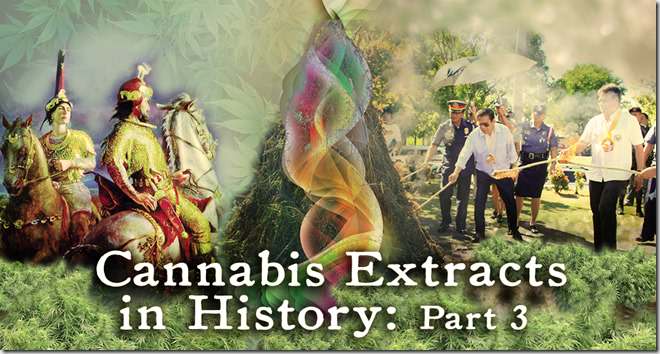Cannabis discovered in Viking grave
One of the women on the Oseberg ship was found with a small leather sack full of cannabis. Scientists wonder how she used the plant.
The Oseberg mound dates back to 834 AD, and is the richest Viking burial ground that has ever been discovered. It was dug up in the year of 1904, and consisted of a Viking ship with two women in it, a young person around 50 years old, and an elderly person between the ages of 70 and 80. They brought with them seven beds, several woven tapestries, a richly decorated chariot, and four horse sleighs. There were also animal bones discovered from 14 or 15 horses, four dogs, a cow, a bull, a red-breasted merganser, and a Eurasian woodcock. The objects were very well preserved bearing in mind how long they had been buried.

The Oseberg ship Photo Credit:
It was so well preserved because of the dense clay and peat that it was buried in. During the excavations, archaeologists discovered a bucket of apples which were still red, as well as cress and blueberries. Additionally, they discovered a lump of raised bread dough that could have intended as a funerary gift; something for the women to cook immediately after they reached the afterlife.
The most interesting puzzle is the two female skeletons. Who were these ladies?
They must have been quite influential within their community to be given such a burial. Average people were not buried in ships or with so many valuable objects. So these women might have been religious and political leaders. It is unclear which of the two women held the most power.
It appears that one woman was bigger than the other. The older woman definitely was eating very well, she was close to 80 years old, which was very old for a Viking woman. The younger one was 50 years old.
Their skeletons showed that they lived for a while, and the oldest had different health issues; it was most likely cancer that was the root of her death.
Cannabis in a Leather Pouch

Cannabis
The older woman was holding a leather sack that has received a lot of attention because of its contents. She would have suffered from a lot of pain because of her illness, and it is speculated that the cannabis that was discovered in her sack was used as a painkiller. Given her possible status as a religious leader, it may have had spiritual connotations and been used in rituals.
The Vikings had an outstanding knowledge of which plants could be utilized for what, some could be used to cure diseases and alleviate pain, whilst others were intoxicants, like cannabis.
There is another possible explanation for the cannabis discovered within the Oseberg ship; in the Viking Age people used hemp to create rope and clothes, it might have been intended for the women to use the cannabis in the afterlife as a building material.
One of the women on the Oseberg ship was found with a small leather sack full of cannabis. Scientists wonder how she used the plant.
The Oseberg mound dates back to 834 AD, and is the richest Viking burial ground that has ever been discovered. It was dug up in the year of 1904, and consisted of a Viking ship with two women in it, a young person around 50 years old, and an elderly person between the ages of 70 and 80. They brought with them seven beds, several woven tapestries, a richly decorated chariot, and four horse sleighs. There were also animal bones discovered from 14 or 15 horses, four dogs, a cow, a bull, a red-breasted merganser, and a Eurasian woodcock. The objects were very well preserved bearing in mind how long they had been buried.

The Oseberg ship Photo Credit:
It was so well preserved because of the dense clay and peat that it was buried in. During the excavations, archaeologists discovered a bucket of apples which were still red, as well as cress and blueberries. Additionally, they discovered a lump of raised bread dough that could have intended as a funerary gift; something for the women to cook immediately after they reached the afterlife.
The most interesting puzzle is the two female skeletons. Who were these ladies?
They must have been quite influential within their community to be given such a burial. Average people were not buried in ships or with so many valuable objects. So these women might have been religious and political leaders. It is unclear which of the two women held the most power.
It appears that one woman was bigger than the other. The older woman definitely was eating very well, she was close to 80 years old, which was very old for a Viking woman. The younger one was 50 years old.
Their skeletons showed that they lived for a while, and the oldest had different health issues; it was most likely cancer that was the root of her death.
Cannabis in a Leather Pouch

Cannabis
The older woman was holding a leather sack that has received a lot of attention because of its contents. She would have suffered from a lot of pain because of her illness, and it is speculated that the cannabis that was discovered in her sack was used as a painkiller. Given her possible status as a religious leader, it may have had spiritual connotations and been used in rituals.
The Vikings had an outstanding knowledge of which plants could be utilized for what, some could be used to cure diseases and alleviate pain, whilst others were intoxicants, like cannabis.
There is another possible explanation for the cannabis discovered within the Oseberg ship; in the Viking Age people used hemp to create rope and clothes, it might have been intended for the women to use the cannabis in the afterlife as a building material.
























